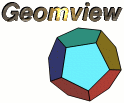 Home Overview FAQ Documentation Download Mailing List Geomview For Windows? Support Users Development Bug Reporting Contributing Contact Us Sponsors
|
[Date Prev][Date Next][Thread Prev][Thread Next][Date Index][Thread Index] [Closed REQ 5174]:
>I am using the Mathematica packages OOGL.m and Geomview.m to display
>directly in Geomview the graphics of produced by Mathematica, but I
>want display directly the animations made in Mathematica. Exist a
>similar packages to the OOGL.m and Geomview.m that can do it?. Could
>you said me how display animations of Mathematica directly to the
>Geomview. Thanks.
A Mathematica animation is a "flipbook" of 2D Postscript images. You
can see a similar "flipbook" of 3D data files in Geomview, using the
Animator external module. After it loads in all the data files, you
can play them back quickly. You can still use the normal motion
controls of Geomview while the Animator is flipping through the
objects.
You'll need to use the "WriteOOGL" command inside a loop on an entire
sequence of Graphics3D or SurfaceGraphics objects, which will create
a sequence of individual OOGL files on disk. You can then start the
Animator module from the Geomview module browser, and load in the
files on its control panel.
Here's an example:
In[1]:= graphs = Table[ Plot3D[ BesselJ[0, Sqrt[x^2+y^2] +t],
{x,-10,10},{y,-10,10},PlotRange->{-.5,1.},
Axes->False,DisplayFunction->Identity]
, {t,0,8} ]
(Notice that we're setting DisplayFunction to Identity so that it
doesn't draw pictures during the computation.)
In[2]:= fnames = Table[ToString[StringForm["/tmp/anim.``oogl",
PaddedForm[t,{1,0},NumberPadding->{"0","0"}]]],{t,0,8}]
(The PaddedForm is so that we create strings like "anim.02.oogl",
so that the files are loaded in the right order. Otherwise
"anim.2.oogl" comes before "anim.20.oogl".)
In[3]:= <<OOGL.m
(You can just load in OOGL.m instead of Geomview.m, since you don't
want to send the graphics directly to Geomview the normal way. (If
Geomview.m has already been loaded, then WriteOOGL is already defined.))
In[4] := MapThread[WriteOOGL,{fnames,graphs}]
(Finally, apply WriteOOGL to the tables.)
In[5] := Quit
The following files are now in the /tmp directory:
anim.00.oogl anim.03.oogl anim.06.oogl
anim.01.oogl anim.04.oogl anim.07.oogl
anim.02.oogl anim.05.oogl anim.08.oogl
Start up Geomview and the Animator, and type "/tmp/anim.*.oogl" into
the input at the bottom of the Animator panel. After the files ahve
been loaded, you can control them with the buttons on the panel (Play,
Bounce, Step, etc.).
Hope this helps,
Tamara Munzner The Geometry Center ((555) 555-5555
munzner at geom.umn.edu http://www.geom.umn.edu/people/munzner.html
|
||
|
Home | Overview | FAQ | Documentation | Support | Download | Mailing List Windows? | Development | Bug Reporting | Contributing | Contact Us | Sponsors |
|||
|
site hosted by |
|||